Buyer’s Guide to Handheld Dynamometers
Available in:
EN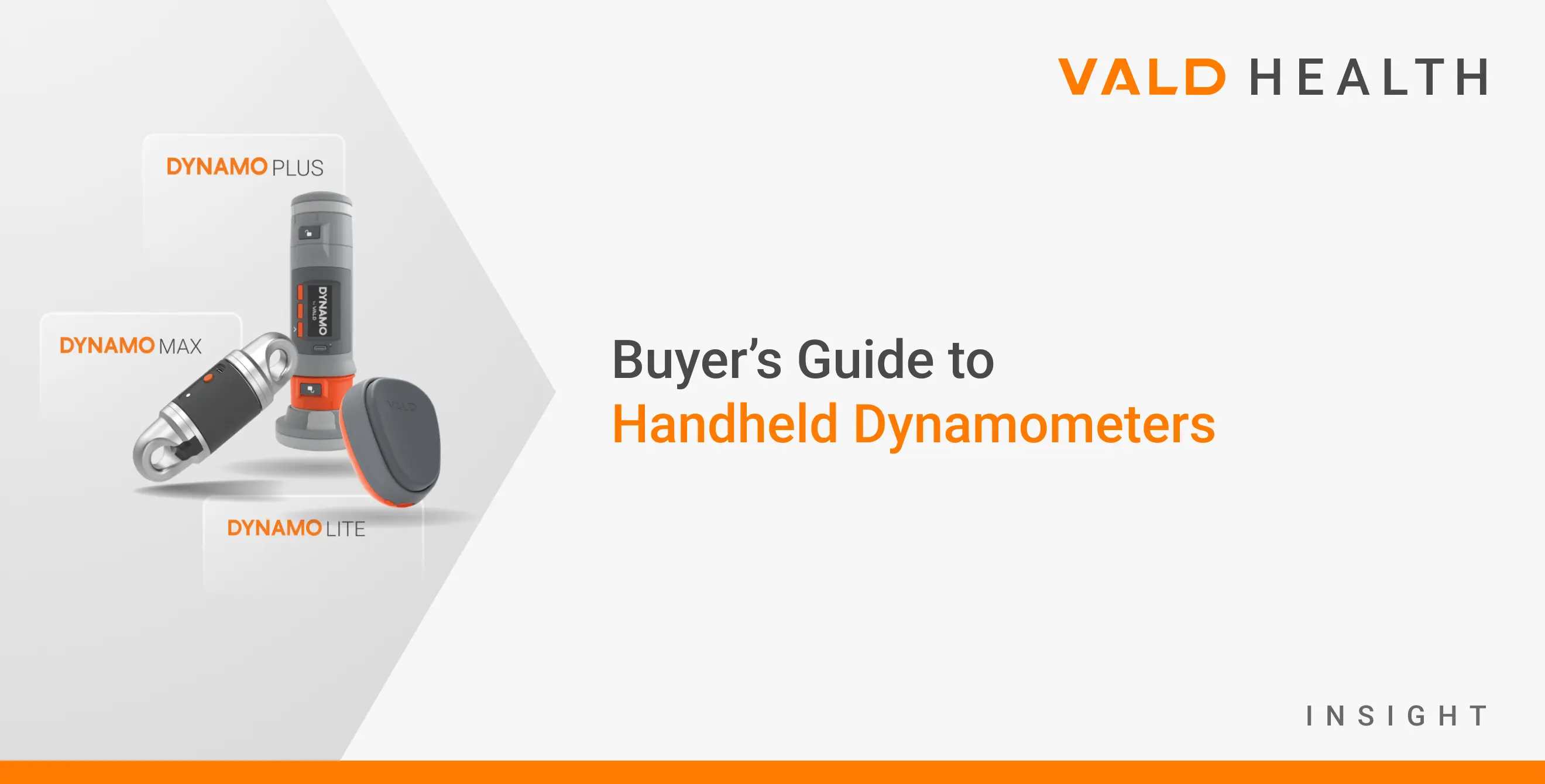
Handheld dynamometers (HHDs) are essential tools in health, rehabilitation and performance settings. Despite being around for over 150 years, HHDs have advanced considerably in recent years. While all modern HHDs assess muscle strength, advancements in hardware and software distinguish them by enhancing measurement accuracy, expanding testing capabilities and integrating data analysis for deeper insights.
Evolution of HHDs
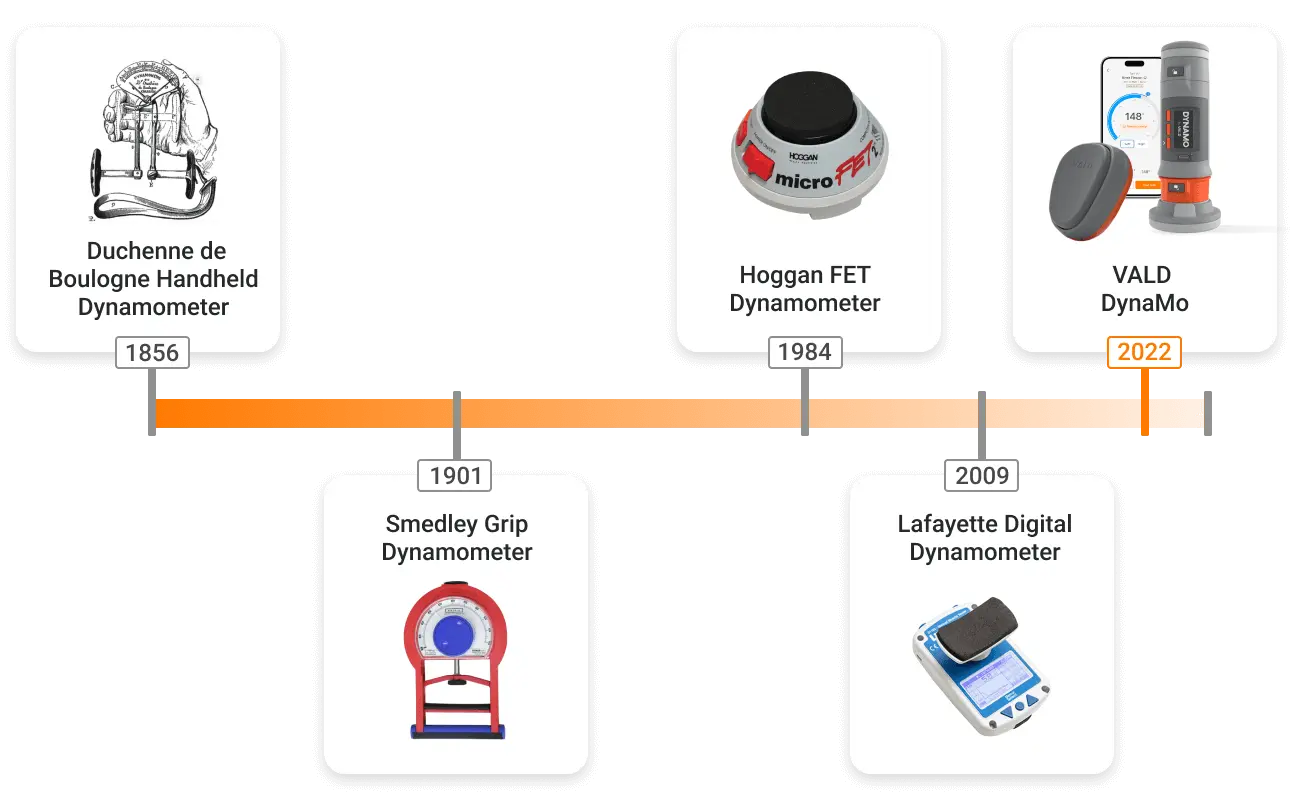
The evolution of handheld dynamometry – from basic mechanical tools to digital systems with advanced data capture, analysis and integration.
Beyond measuring strength, modern HHDs provide data management and visualization solutions, additional insights such as rate of force development (RFD) and asymmetry analysis, and even various types of strength testing such as tension, compression and fixed-point testing all from one device.
Before diving deeper, if you are new to HHDs and curious about their role in health and performance settings for assessing and monitoring patients and athletes, start your journey with this article: Handheld Dynamometers 101.
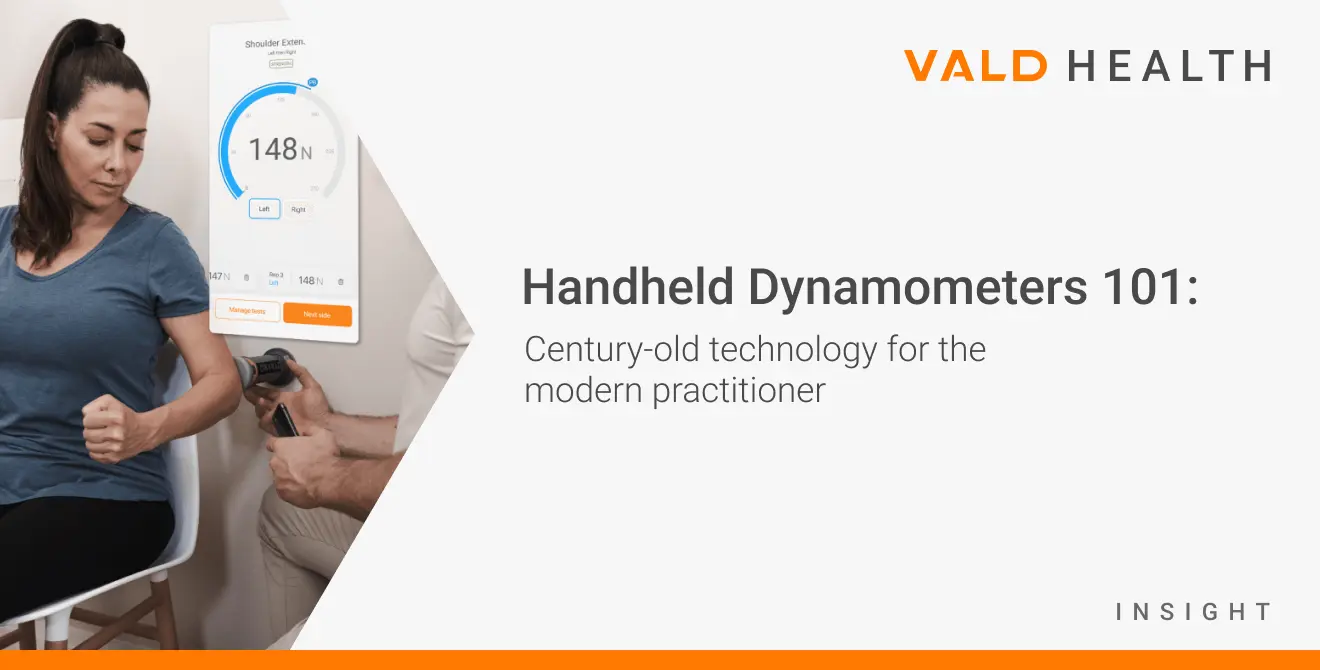
Now that you have a foundational understanding of HHDs, the next step is determining which model best suits your specific environment. In the sections that follow, we will provide you with a basic understanding of the key factors to keep in mind when making your decision.
Understanding HHDs
Technological advancements have significantly refined the capabilities of HHDs. For instance, what used to be separate devices – dynamometers for measuring tension, compression and grip strength, and even inclinometers for measuring ROM – have now been combined into a single, more efficient tool.
…what used to be separate devices…have now been combined into a single, more efficient tool.
VALD’s DynaMo range is one such example, allowing a single HHD to perform the same tests that may have previously required up to four separate devices.
The DynaMo range has been designed to provide research-grade technology from clinical to performance settings – offering three models within one easy-to-use system.
| Product | Description | Application |
|---|---|---|
|
DynaMo Lite
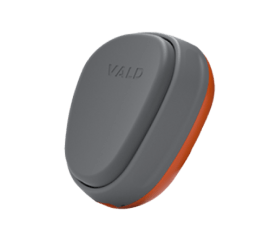 | Designed for handheld tests, this model is ideal for practitioners who require simple, handheld strength and range of motion (ROM) assessments. | DynaMo Lite is a compression-only dynamometer and inclinometer that fits in the palm of your hand or in a pocket and is even wearable via Velcro limb wraps. Its compact design makes it a practical choice for smaller clinics or individual practitioners needing basic yet reliable measurements. |
|
DynaMo Plus
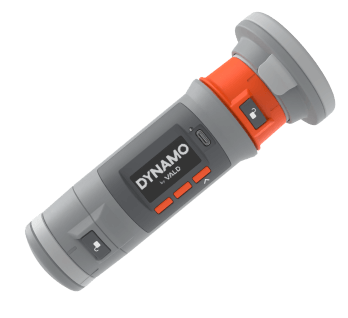 | The most versatile DynaMo model, DynaMo Plus, is a tension and compression dynamometer and inclinometer. It includes additional features such as an inbuilt OLED screen, NFC-enabled Smart Attachments and a dedicated grip attachment. | DynaMo Plus can perform over 400 tests, offering roughly 100 more tests than DynaMo Lite, making it ideal for practitioners who require a broader range of assessments and value tension and grip testing to gain more detailed insights into their patients’ or athletes’ performance. |
|
DynaMo Max
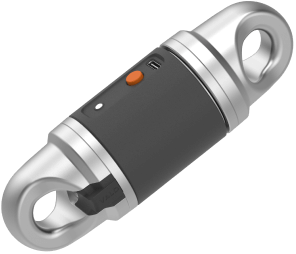 | Featuring the highest capacity of the range, DynaMo Max is designed for the most demanding tests. Alongside inclinometry ROM assessments, it includes tension and compression Smart Attachments capable of a 1,000kg load capacity and 1,200Hz sampling rate. | DynaMo Max offers optional extras such as dedicated attachments for isometric mid-thigh pull (IMTP) and belt squat testing, along with a range of other attachments that expand its capabilities for performance and rehabilitation assessments. |
This integration reflects a broader trend in HHD development, where versatility and comprehensive functionality are prioritized to cater to diverse needs from clinical to performance settings.
However, not all HHDs’ features are the same, with significant variance from brand-to-brand and model-to-model. Closely review the specifications of the HHDs before making your decision to ensure you do not miss out on any features that will be important to you.
To support your decision-making, here is a breakdown of key specifications across the DynaMo range:
| DynaMo Lite | DynaMo Plus | DynaMo Max | |
|---|---|---|---|
|
Features and Specifications
|  |  |  |
|
Weight
| 250g (0.55lbs) | 300g (0.67lbs) | 1.5kg (3.30lbs) |
|
Size
| 95(L) x 73(W) x 42(H) mm 3.7(L) x 2.8(W) x 1.6(H) in | 134(L) x 53(W) x 53(H) mm 5.2(L) x 2(W) x 2(H) in | 134 (L) x 53(W) x 53(H) mm 5.2(L) x 2(W) x 2(H) in. |
|
Load Capacity
| Compression – 100kg (220lbs) | Compression – 100kg (220lbs) Tension – 200kg (440lbs) | Compression – 1,000kg (2,200lbs) Tension – 1,000kg (2,200lbs) |
|
Inertial Sensor (IMU)
|
9-Axis IMU:
|
9-Axis IMU:
|
9-Axis IMU:
|
|
Sampling Frequency
| Up to 225Hz | Up to 225Hz | Up to 1,200Hz |
|
Included Attachments
| S/M/L limb wraps, adjustable strength strap |
|
|
|
Optional Expansion Package
|
|
|
Want more details? Check out the DynaMo specifications.
A Quick Note on the Accuracy and Reliability of HHDs
When it comes to ensuring accurate and reliable muscle strength measurements, how a HHD is built is just as important as how it is used. The design and material quality of the HHD itself can play a significant role in measurement reliability. Devices that use weaker materials (such as cheap plastics), lack sufficient internal reinforcement and use low-capacity sensors may flex or “bottom out” under higher loads, leading to inconsistent force readings.
Devices that use weaker materials, lack sufficient internal reinforcement and use low-capacity sensors may flex or “bottom out” under higher loads…
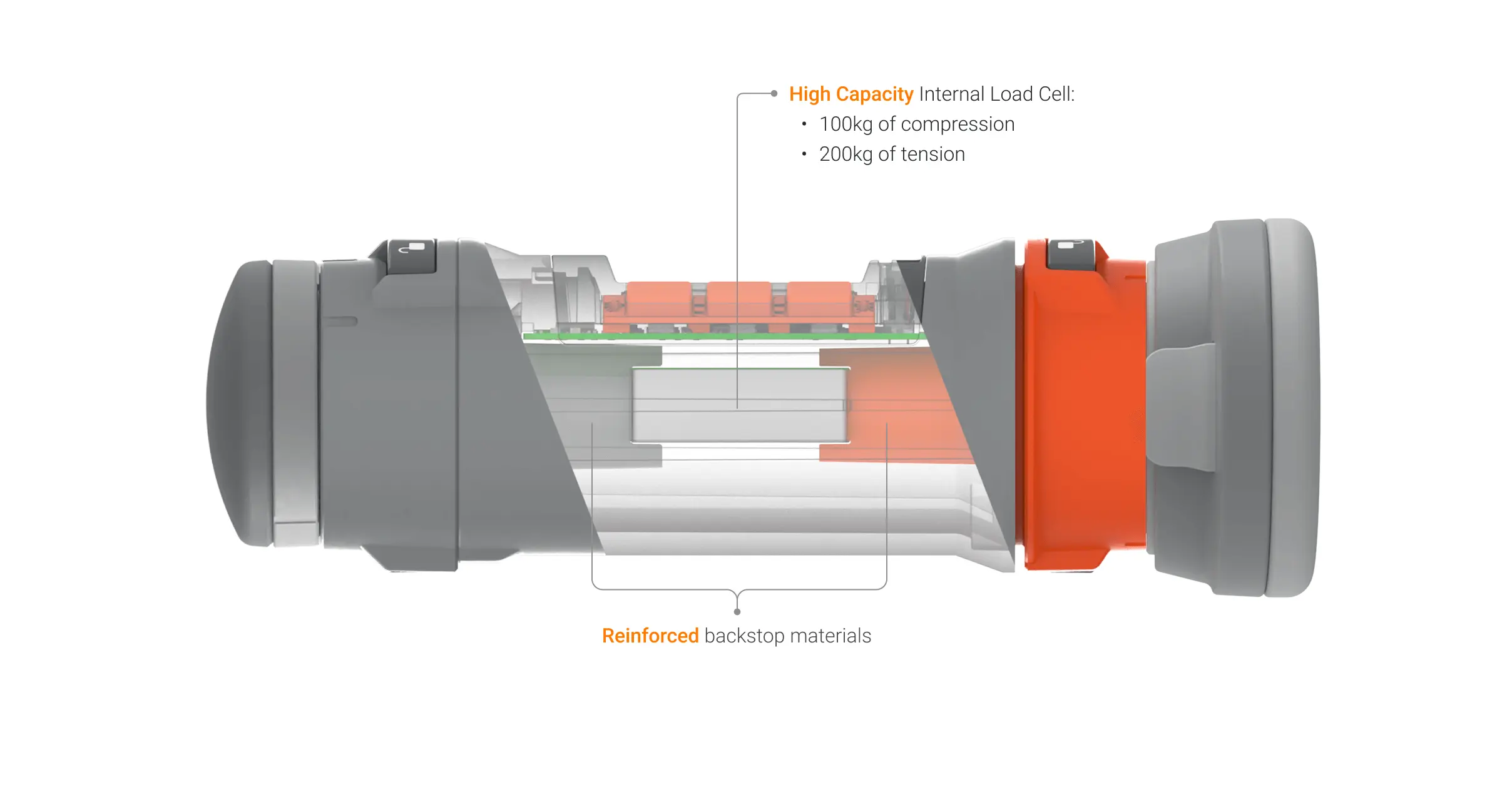
DynaMo Plus addresses typical dynamometry issues – such as low force measurement capacity and weak materials found in some commercial devices – with a reinforced design and high-capacity load cells.
This is a known issue in some commercial devices, where the housing deforms under pressure, compromising the integrity of the measurement even before other factors such as testing protocols or software are considered. While these devices may appear cost-effective on the surface, these design compromises can result in significant inaccuracies.
Beyond hardware quality, not all HHDs provide the level of accuracy needed for effective muscle strength assessment in health, sports and rehabilitation settings. While the intricacies of their technical accuracy are complex, buyers can use simple indicators to build trust in their purchasing decision, from reading reliability and validity reports to identifying existing reputable users of the product.
For example, recent research by Collings et al. (2025) demonstrated that DynaMo Plus has excellent grip strength reliability compared to the gold-standard Jamar dynamometer, helping practitioners trust the consistency and accuracy of their assessments.
[A 2025 study] demonstrated that DynaMo Plus has excellent grip strength reliability compared to the gold-standard Jamar dynamometer…
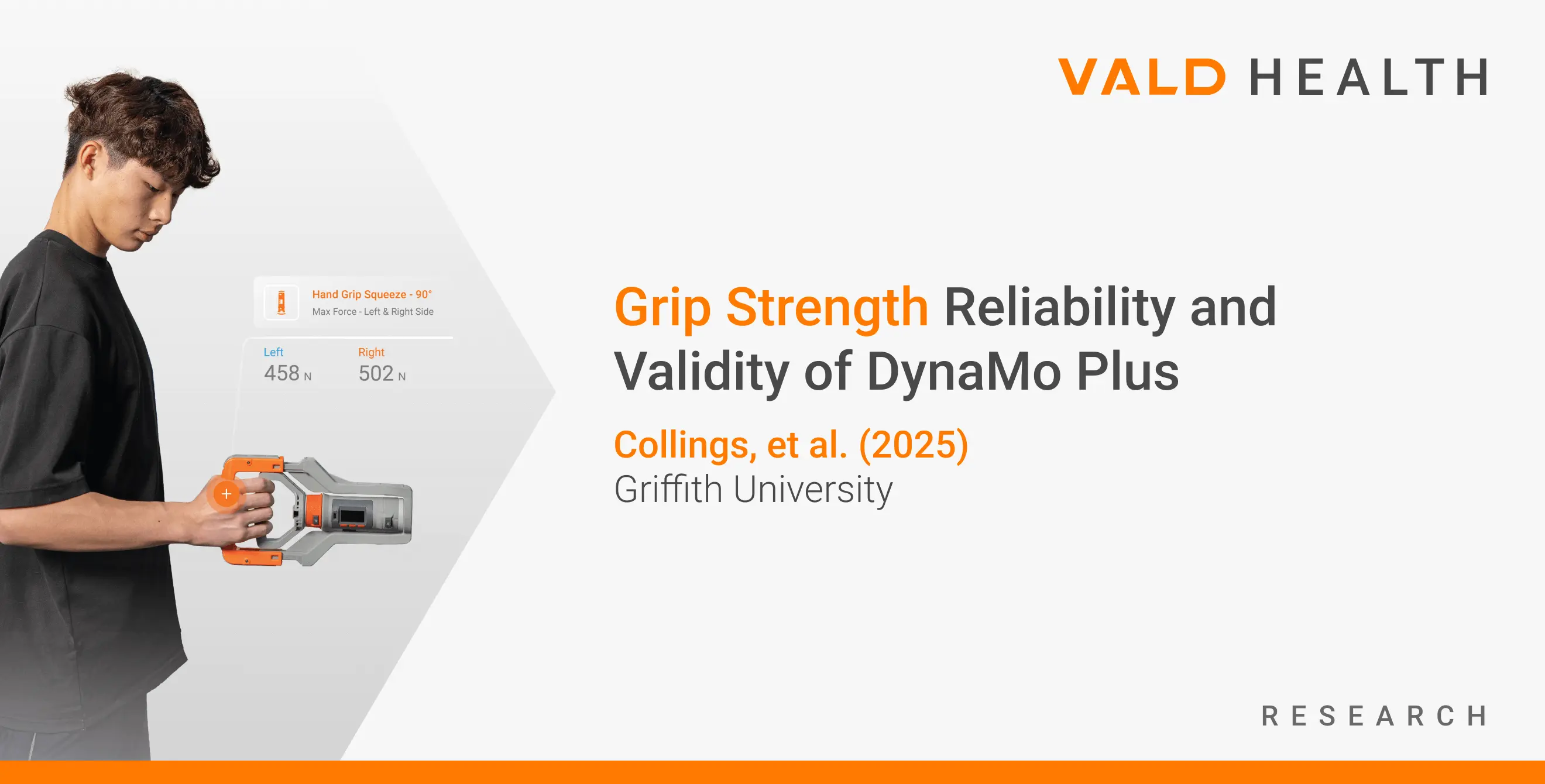
DynaMo is also trusted across clinical, rehabilitation and performance settings by leading healthcare providers, national defense departments and elite sporting organizations, including teams from the Premier League, NFL, MLB, NBA and more.
Ultimately, however, HHDs’ accuracy is influenced most by the people using them – namely the consistency and quality of practitioners’ testing procedures. Implementing reliable testing protocols and maintaining uniformity in data analysis (e.g., using the same model of HHD, accompanying software and measuring metrics consistently) are crucial steps toward ensuring data accuracy in day-to-day practice.
To support this, VALD provides access to more than 400 testing protocol videos to help practitioners implement consistent assessments.
Equally important is selecting a device that suits your testing context. To help with this, we have outlined three key considerations to keep in mind when making your selection:
- Who are you going to be conducting your HHD testing on?
- What are you looking to measure with your HHD testing?
- Where are you going to be conducting your HHD testing?
Key Considerations When Choosing an HHD
When evaluating which HHD is right for you, consider how the following three factors impact your decision-making:
Who Are You Using Your HHD With?
When selecting an HHD, it is essential to consider who you will be testing – be it elite athletes, geriatric populations, orthopedic post-operative patients or a diverse combination. These groups have different needs, and those needs should guide your choice of specifications and features. For example:
- Athletes generate higher peak forces – particularly in lower limb tests – and may require more advanced performance profiling. Therefore, a device like the DynaMo Max with a higher load capacity, faster sampling rate and advanced reporting options may be preferable to ensure metrics like peak force and RFD can be captured consistently.
- Geriatric patients may present with limited mobility, reduced strength or balance issues. A compact, ergonomic device – such as DynaMo Lite and DynaMo Plus – that can be easily positioned and used in supported setups is ideal for ensuring patient comfort and test consistency without adding complexity to the assessment.
- Post-operative patients, particularly in the early phases of rehabilitation, may present with pain, swelling or limited ROM. A HHD that allows for supported test positions, controlled loading and repeatable setup – like DynaMo Plus – can help ensure comfort while still capturing accurate and meaningful data to track the recovery progress.
These groups have different needs, and those needs should guide your choice of specifications and features.
What Types of Tests Do You Want to Perform?
The majority of health and performance specialists use their HHDs to perform the following types of tests:
- Tension strength testing
- Compression strength testing
- Grip strength testing
- ROM testing*
*Traditionally performed using a separate goniometer or inclinometer.
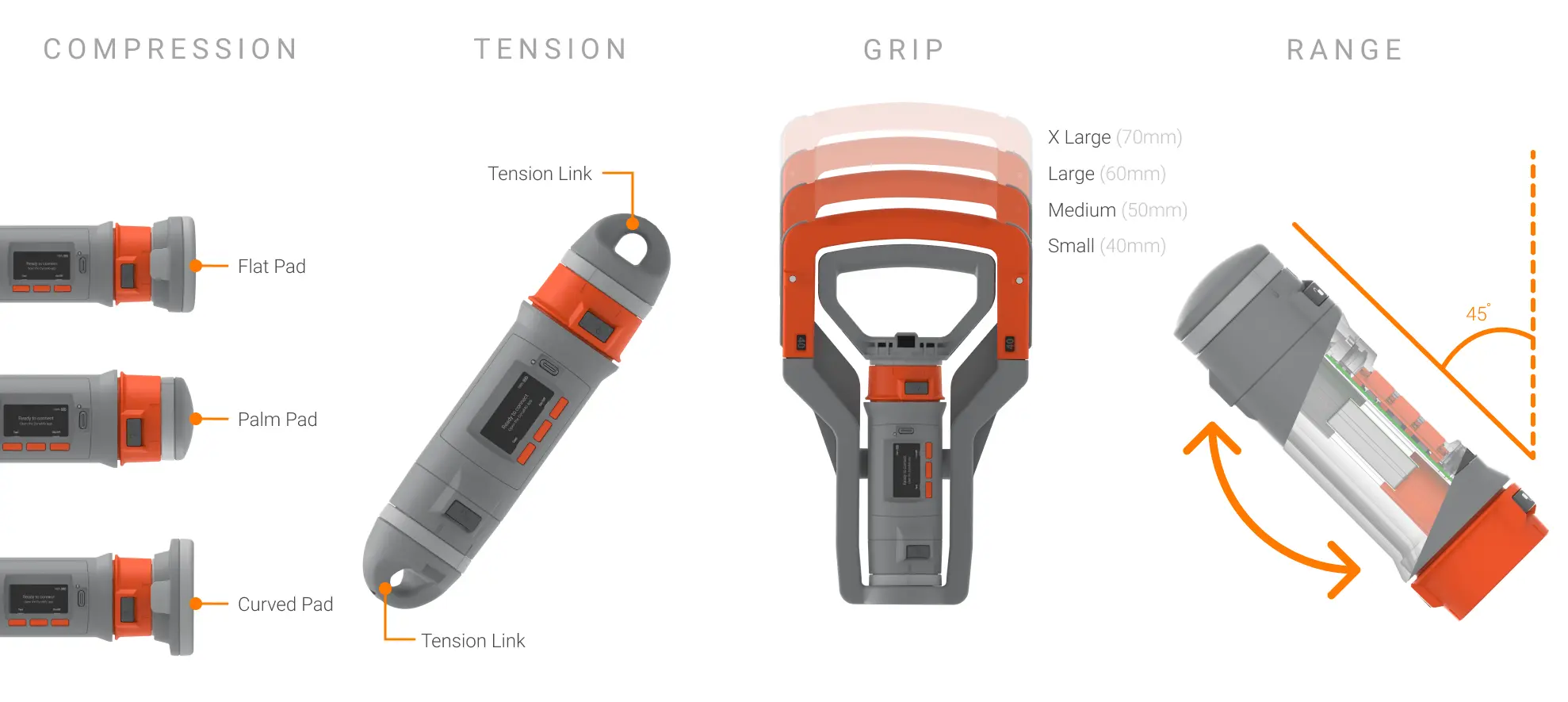
The modular design of DynaMo Plus essentially combines four devices into one.
To support these test types, the DynaMo range includes interchangeable attachments and multiple testing modes. DynaMo Lite enables compression and fixed-point testing, while DynaMo Plus and DynaMo Max add tension testing – expanding the range of assessments that can be conducted.
*DynaMo Lite has a pinch grip assessment option that assesses grip strength differently than DynaMo Plus.
The choice of test type typically depends on the movement being assessed and the body region involved, and this modularity allows practitioners to adapt their setup to suit the testing environment – whether that is in a clinic, gym or on the road.
With this versatility, practitioners can perform a variety of testing protocols across DynaMo Lite, DynaMo Plus and DynaMo Max, including:
|
|
DynaMo Lite
|
DynaMo Plus
|
DynaMo Max
| |||
|
|
Strength
|
ROM
|
Strength
|
ROM
|
Strength
|
ROM
|
| Neck |
 |
 |
 |
 |
 |
 |
| Shoulder |
 |
 |
 |
 |
 |
 |
| Scapula |
 |
 | ||||
| Trunk |
 |
 |
 |
 |
 |
 |
| Elbow |
 |
 |
 |
 |
 |
 |
| Wrist |
 |
 |
 |
 |
 |
 |
| Hand |
 |
 |
 | |||
| Hip |
 |
 |
 |
 |
 |
 |
| Knee |
 |
 |
 |
 |
 |
 |
| Ankle |
 |
 |
 |
 |
 |
 |
| Hand |
 |
 |
 | |||
The DynaMo range not only supports strength and ROM testing across all major joints and muscle groups but also allows clinicians to create and save a battery of tests that can be performed in quick succession, tailored to specific assessment goals.
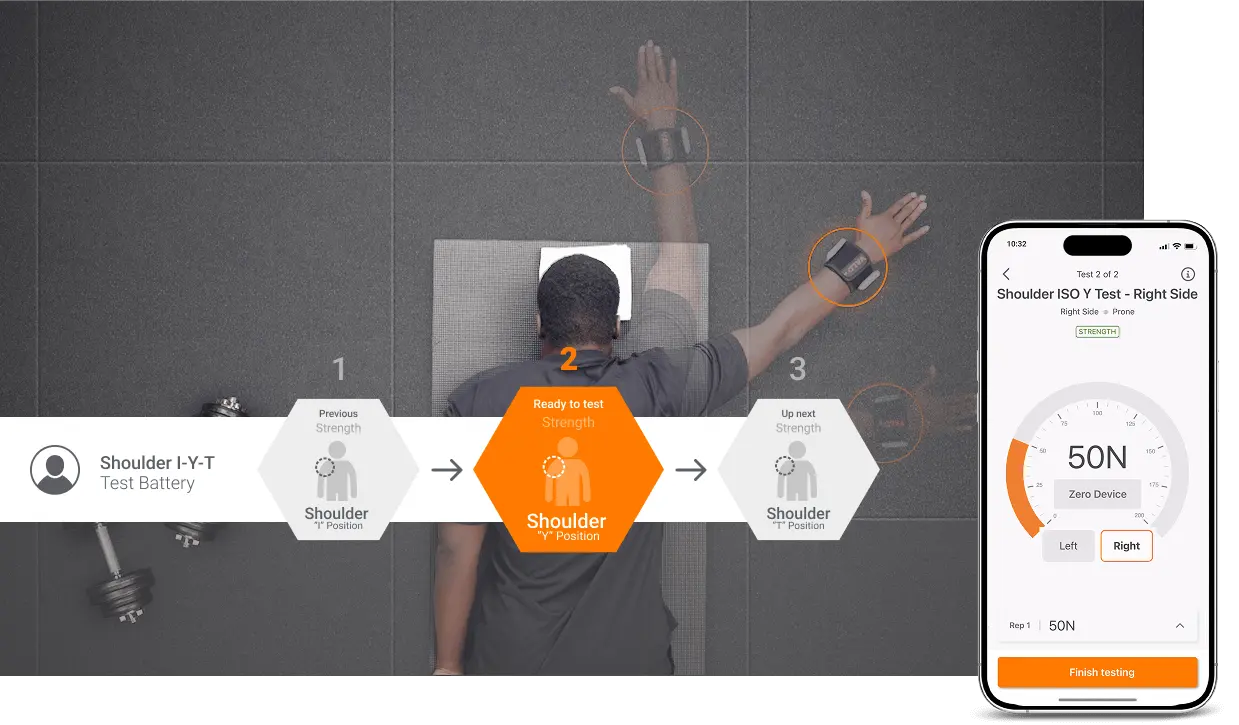
Streamline your workflow with test batteries, such as this shoulder I-Y-T test battery with DynaMo Lite.
What Data and Metrics Do You Want to Analyze?
This is where software’s ability to accurately acquire, interpret and present data from the HHD becomes a critical factor in its overall effectiveness. For professionals managing the health and performance of patients or athletes, the software functionality of an HHD is not just an added feature – it is often the most important consideration.
…the software functionality of an HHD…is often the most important consideration.
The effectiveness of an HHD extends beyond physical measurements to its software capabilities, which not only capture and interpret data in real time but also allow for a streamlined workflow. Platforms like the DynaMo ecosystem, including VALD Hub and MoveHealth, help bring this data to life.
The DynaMo app includes in-app Norms, allowing clinicians to instantly compare results to age- and sex-matched benchmarks during testing. Paired with VALD Hub, VALD’s centralized system for managing, storing and monitoring patient data, practitioners can view results immediately, access detailed reports or send printed records with ease – moving away from outdated systems.
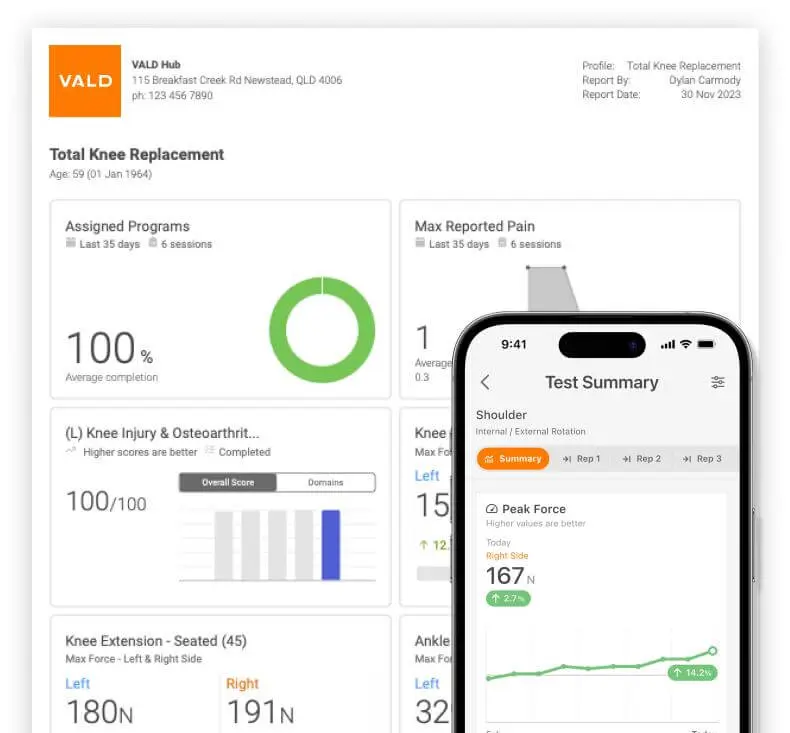
Visualize progress with printable data reports and longitudinal data tracking.
This software functionality is essential in determining the value you get from your HHDs. A system that can swiftly and accurately analyze data and then present it in an easily readable format enhances the user experience for both practitioners and their patients, reducing the time working on your patients and more time working with them.
One example of this is DynaMo’s integrated software solutions, which are designed to make data interpretation as insightful and user-friendly as possible – supporting clinical decision-making and performance tracking.
DynaMo's software stands apart by analyzing a wider range of tests and calculating more metrics, including:
- Peak Force: Captures the maximum force generated during a test; used for tracking strength progress, comparing sides and setting baselines.
- Asymmetry: Identifies strength imbalances between limbs or movements, supporting injury risk screening and more tailored treatment plans.
- Time to Peak Force: Measures how quickly peak force is reached, offering insights into neuromuscular control and potential deficits in explosive output.
- RFD: Reflects how rapidly force is generated over time, making it valuable in high-performance profiling and rehabilitation progressions.
- ROM: Measures the full movement potential of a joint, helping to track mobility improvements or detect functional limitations – supporting both clinical recovery and performance benchmarks.
These metrics are calculated automatically, providing longitudinal charts for effective progress tracking and integrated Norms (normative data) directly into every patient profile on VALD Hub. This ensures that the DynaMo range not only provides comprehensive data but also helps practitioners translate it into actionable insights.
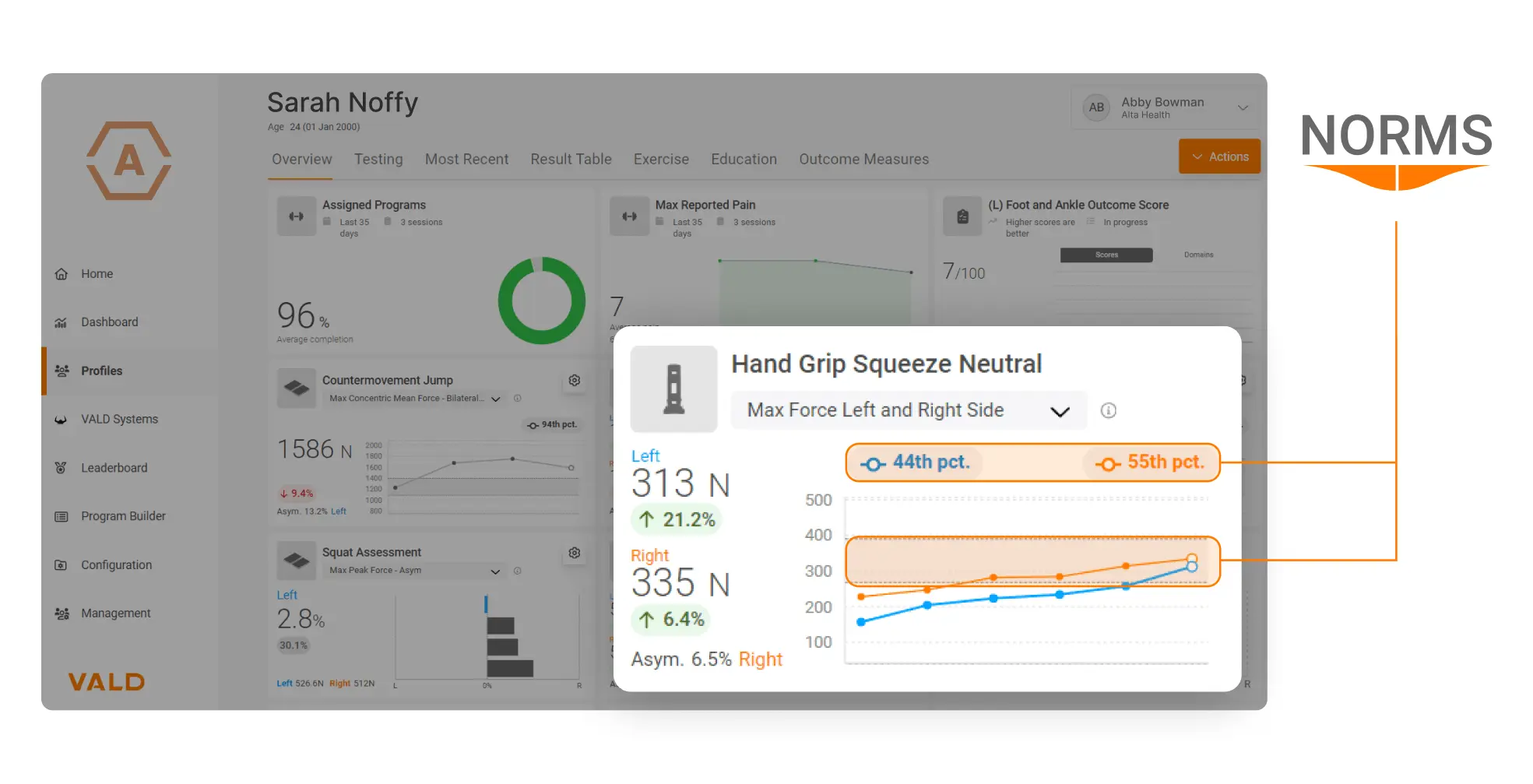
Norms can be used to compare an individual’s results over time and are available for almost all DynaMo strength tests and metrics, including bilateral metrics.
As well as being instantly available to practitioners in VALD Hub, DynaMo results (along with all other VALD systems’ data) also sync immediately to MoveHealth – VALD’s centralized patient app.
MoveHealth combines exercise prescription, PROMs, educational content and test result monitoring to create a single place for patients’ musculoskeletal (MSK) health journey. Like an MSK-specialized equivalent of Apple Health or Google Health, patients can view and complete their exercise programs, track progress and view their own testing results in-app, helping them stay engaged and informed throughout their rehabilitation or performance journey.
All this data also syncs with MoveHealth…helping [patients] stay engaged and informed throughout their rehabilitation or performance journey.
Many HHDs feature data outputs and dedicated apps. However, many of the specific features here are unique to DynaMo. When making your purchasing decision, ensure you understand the capabilities of the software of the HHDs you are considering, as they can be just as important – if not even more important – than the capabilities of their hardware.
Where Are You Going to Use Your HHD?
The versatility of HHDs allows them to be used across a broad range of environments – from clinics and gyms to on-field settings and off-site patient visits. Where you test often shapes how your device needs to be secured or anchored, particularly for fixed-point setups, such as those required for tension-based strength assessments.
Where you test often shapes how your device needs to be secured or anchored, particularly for fixed-point setups, such as those required for tension-based strength assessments.
For example, performing tension-based strength assessments typically requires anchoring the device to a stable structure – such as a bed, squat rack or wall-mounted rig. This means your environment needs to support these setups, whether through permanent fixtures or portable attachments. Models like DynaMo Plus and DynaMo Max are designed to accommodate these needs with a range of attachment options that support reliable, repeatable testing in a variety of clinical and performance settings.
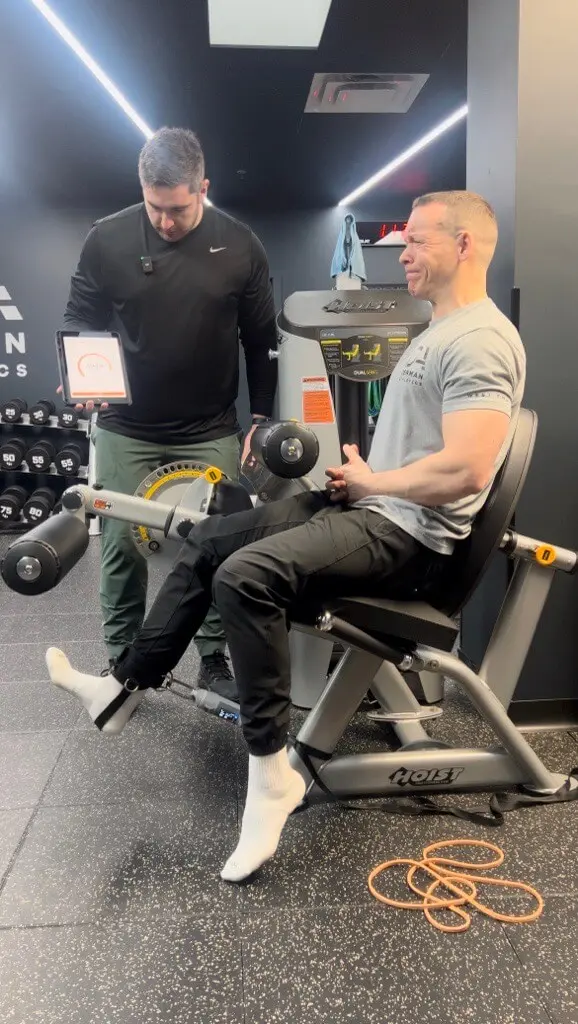
Knee extension tension test using DynaMo Plus.
Some assessments, such as IMTP, are typically restricted to gym environments due to their high load requirements and need for a rigid setup. However, some systems, such as DynaMo Max with its optional IMTP attachment, offer ways to perform these assessments outside traditional settings, giving practitioners greater flexibility in where testing can occur.
Ultimately, thinking ahead to where you will be conducting most of your tests will help guide your decision. Whether you are working in a space-limited clinic, on the road with athletes or in a fully equipped facility, aligning your HHD choice with your environment ensures a smoother and more effective workflow.
What Is Your Budget, and Which Technology Partner Are You Choosing?
Once you have decided to invest in HHD technology and have a clear understanding of the features you need, the final step is to determine which brand and model align best with your budget. While many health and performance professionals seek advanced muscle strength analysis, it's important to remember that higher cost does not always mean greater capability.
When comparing HHD options, it is crucial to consider not just the initial cost but what is included in that price and – just as importantly – what is not included. For example, some devices may not include access to software updates, ongoing support, extended warranties or training resources, all of which can significantly affect long-term value and usability. In turn, the right choice balances budget constraints with the functionalities required for the intended use.
…consider not just the initial cost but also what is included in that price…[as] the right choice balances budget constraints with the functionalities required for the intended use.
At VALD, we understand that and therefore offer various models of HHDs, each tailored to meet different professional requirements and payment plans that suit your business. VALD’s pricing model is designed to offer flexibility, making high-quality technology more accessible across a wide range of budgets and practice types.
Every VALD subscription includes:
- Access to measurement devices
- Unlimited use of software and new features
- Unlimited support and training
- Comprehensive warranty
- All-inclusive pricing with no hidden costs
Flexible billing options are also available – whether you prefer weekly, monthly, quarterly, annually or all upfront – with no penalties for paying in smaller, more frequent installments.
To assist you in making an informed decision, detailed information on the features and pricing of our DynaMo Lite, DynaMo Plus and DynaMo Max is available via our online store, where you can explore each option and sign up for the model that best fits your needs.
We know that purchasing an HHD can be a daunting process, but at VALD, we want to help you make the right decision – even if it turns out that a DynaMo is not the best choice for you. If you would like help with your decision-making process, we are always here to help.

